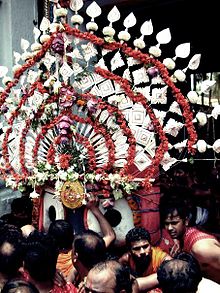Odisha: Jagannath Rath Yatra begins amidst tight security
Priya Ranjan Sahu, Hindustan Times Bhubaneswar, July 10, 2013
The annual celebration of the world famous Rath Yatra (chariot
festival) in Odisha’s temple town of Puri began on Wednesday morning
amid tight security attracting more than 10 lakh devoees from across the
country and abroad.
The festival marks the annual journey of Lord Jagannath, Lord Balabhadra and Devi Subhadra, deities from the 12th century Jagannath Temple, in three colourfully decked up huge wooden chariots to the temple of Devi Gundicha (their aunt). The celebration ends nine days later with Bahuda Yatra (return journey) to the Jagannath Temple.
Elaborate security arrangements were made during the festival in view of the recent bomb attack on Bodh Gaya temple, police said.
“More than 100 platoon security forces were deployed to maintain law and order. Besides, the vessels of Indian Coast Guard will keep a watch on the coast,” Puri superintendent of police Anup Sahu said.
The police have kept bomb disposal squads ready to meet any eventuality and installed CCTV cameras at vital locations.
Rath Yatra at Puri
The Jagannath triad are usually worshiped in the sanctum of the temple at Puri, but once during the month of Asadha (Rainy Season of Orissa, usually falling in month of June or July), they are brought out onto the Bada Danda (main street of Puri) and travel (3 km) to the Shri Gundicha Temple, in huge chariots (ratha), allowing the public to have darśana (Holy view). This festival is known as Rath Yatra, meaning the journey (yatra) of the chariots (ratha). The Rathas are huge wheeled wooden structures, which are built anew every year and are pulled by the devotees. The chariot for Jagannath is approximately 45 feet high and 35 feet square and takes about 2 months to construct [5]. The artists and painters of Puri decorate the cars and paint flower petals and other designs on the wheels, the wood-carved charioteer and horses, and the inverted lotuses on the wall behind the throne [6]. The huge chariots of Jagannath pulled during Rath Yatra is the etymological origin of the English word Juggernaut.[7] The Ratha-Yatra is also termed as the Shri Gundicha yatra.
The most significant ritual associated with the Ratha-Yatra is the chhera pahara." During the festival, the Gajapati King wears the outfit of a sweeper and sweeps all around the deities and chariots in the Chera Pahara (sweeping with water) ritual. The Gajapati King cleanses the road before the chariots with a gold-handled broom and sprinkles sandalwood water and powder with utmost devotion. As per the custom, although the Gajapati King has been considered the most exalted person in the Kalingan kingdom, he still renders the menial service to Jagannath. This ritual signified that under the lordship of Jagannath, there is no distinction between the powerful sovereign Gajapati King and the most humble devotee.[8]
Chera pahara is held on two days, on the first day of the Ratha Yatra, when the deities are taken to garden house at Mausi Maa Temple and again on the last day of the festival, when the deities are ceremoniously brought back to the Shri Mandir.
As per another ritual, when the deities are taken out from the Shri Mandir to the Chariots in Pahandi vijay, disgruntled devotees hold a right to offer kicks, slaps and the derogatory remarks to the images, and Jagannath behaves like a commoner.
In the Ratha Yatra, the three deities are taken from the Jagannath Temple in the chariots to the Gundicha Temple, where they stay for seven days. Thereafter, the deities again ride the chariots back to Shri Mandir in bahuda yatra. On the way back, the three chariots halt at the Mausi Maa Temple and the deities are offered Poda Pitha, a kind of baked cake which are generally consumed by the poor sections only.
The observance of the Rath Yatra of Jagannath dates back to the period of the Puranas. Vivid descriptions of this festival are found in Brahma Purana, Padma Purana, and Skanda Purana. Kapila Samhita also refers to Rath Yatra. In Moghul period also, King Ramsingh of Jaipur, Rajasthan has been described as organizing the Rath Yatra in the 18th Century. In Orissa, Kings of Mayurbhanj and Parlakhemundi were organizing the Rath Yatra, though the most grand festival in terms of scale and popularity takes place at Puri.
Moreover, Starza[9] notes that the ruling Ganga dynasty instituted the Rath Yatra at the completion of the great temple around 1150 AD. This festival was one of those Hindu festivals that was reported to the Western world very early. Friar Odoric of Pordenone visited India in 1316-1318, some 20 years after Marco Polo had dictated the account of his travels while in a Genovese prison.[10] In his own account of 1321, Odoric reported how the people put the "idols" on chariots, and the King and Queen and all the people drew them from the "church" with song and music.[11] [12]





No comments:
Post a Comment